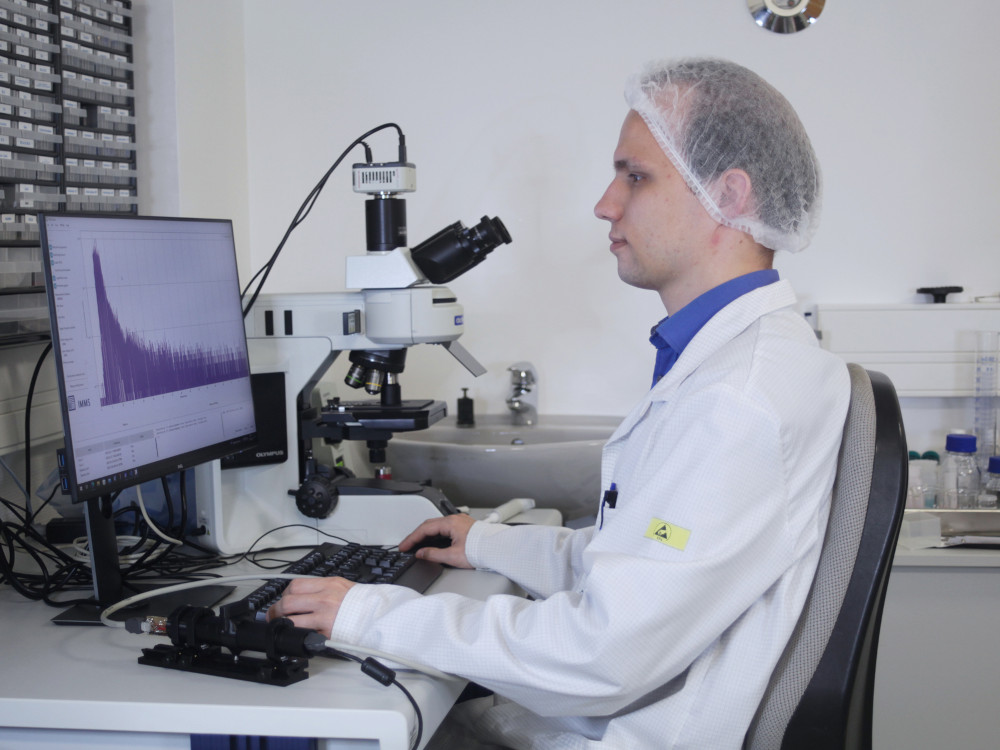11 Sep Young researcher honored for application-oriented work
In order to characterize light pulses with pulse durations down to the nanosecond or picosecond range, fast photodiodes have been used up to now, whose signals were measured with oscilloscopes down to the nanosecond range. However, the background noise of any oscilloscope distorts these measurement results. Better suited is time-correlated single photon counting. The idea of this method is not new, but for a long time it was only possible with relatively bulky hardware with large power requirements.
For developing a low-cost system for measuring light pulses with a resolution of 20 picoseconds, engineering computer scientist Jakob Hampel has now received the Silicon Science Award 2023, which is offered by the CiS Association for the Promotion of Science, Research and Innovation and the CiS Research Institute for Microsensors. The award recognizes challenging research work carried out at a very high level with very high practical benefits. Hampel was honored for his master’s thesis, ‘Time-correlated single photon counting for time-domain characterization of high-speed light sources using configurable logic devices,’ which was supervised by the IMMS Institute for Microelectronic and Mechatronic Systems and the Technical University Ilmenau. According to the researchers at the IMMS, the results are already being incorporated into application developments for point-of-care devices that are intended to enable particularly sensitive analyses for medical and biochemical investigations. In addition, the hardware-software evaluation unit developed for determining impulse responses of fast light sources is an important contribution to research into quantum technologies in the QuantumHub Thuringia project.
Characterizing fast light pulses
“Many applications require fast light pulses, often down to the nanosecond or picosecond range,” Hampel explains. One example, he says, is fluorescence-based bioanalytical processes in medical technology. Light sources that generate these pulses, such as those required for fluorescence, must therefore be characterized. This is the only way to reliably evaluate the response of an optical system, Hampel added. Time-correlated single-photon counting works differently: “In very simplified terms, the light source is excited and then the individual photons and the time delays of the impulse responses are observed. These are accumulated into a histogram by repeated excitation and statistical evaluation of the results of hundreds of thousands to millions of measurements. This then describes the behavior of the light source over time.”
Research result is a palm-sized USB device
In his master’s thesis, Hampel developed the hardware description as well as the readout software to implement time-correlated single-photon counting using a configurable logic device. Together with a single-photon avalanche diode (SPAD) as a light sensor and other analog components implemented at IMMS, he used it to build a low-cost system that can accurately measure light pulses with a resolution of 20 picoseconds and fit into a tube measuring only 100 mm × 25 mm. “Jakob Hampel has specifically used the emergence of commercially available semiconductor-based single photon detectors in recent years, as well as the increasingly powerful configurable logic devices, to address current research questions on increasingly sensitive sensor systems in an exemplary manner in his work,” says Professor Hannes Töpfer, Dean of the Faculty of Electrical Engineering and Information Technology and supervisor of Jakob Hampel’s master’s thesis.

The image shows the preliminary work of the eFluoResYst project launched in 2021 for a test stand featuring single photon detection of fluorescent dyes in a measurement chamber. Image: IMMS
Measuring system for research into quantum technologies
The relevance of his work is also reflected in the fact that it has already led to further developments, such as that for research into quantum technologies in the QuantumHub Thuringia project. Among other things, the IMMS there is working on characterizing semiconductor-based single-photon detectors for use in quantum communication systems.
“Mr. Hampel’s work is not only noteworthy on a technical level,” concludes his supervisor Professor Töpfer, “It also impressively illustrates how the theoretically sound education at the TU Ilmenau is given considerable clout with practice-oriented support services such as those offered at the IMMS. With this, not only can research results be transferred into practice, but also the next generation of scientists can be excellently supported with all the necessary tools for tomorrow’s innovations.”
Further information about the Silicon Science Award
Source and image: www.imms.de






